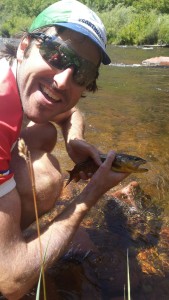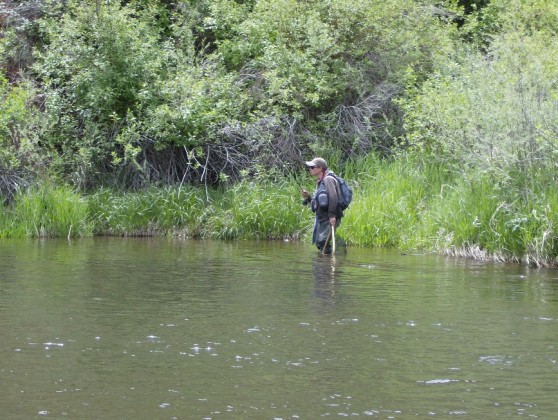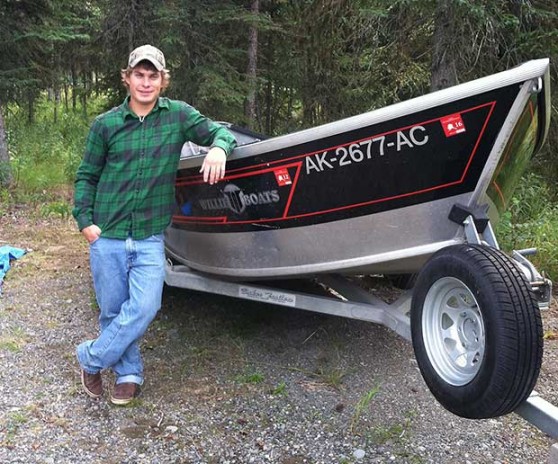Winter in Colorado generally means ski gear is taking up most of the space in your car. But be sure to leave a little room for your waders and rod. Although the weather is colder, fly fishing remains hot. Fishing during the colder months is possibly the most rewarding time of year to fish. Not only does catching a fish justify the hours spent in the cold and wind, and give you a reason to spend more time in some of the best fisheries in the country, but winter trout require much more precise technique and skill than any other time of year.
When the air temperature drops, the water temperature drops with it. Like most fish, trout cannot regulate their body temperature and therefore operate at the same temperature as the water around them. When fish get too cold, they become sluggish and dormant.
 Trout prefer temperature between the ranges of 45-65 degrees Fahrenheit- also known as the Trout Zone. This is no problem for summer days in Colorado when the water remains in this range, but during the winter, the temperature can drop below freezing. In order to survive, trout will find holes or eddies where the water may be warmer and stay low in the water.
Trout prefer temperature between the ranges of 45-65 degrees Fahrenheit- also known as the Trout Zone. This is no problem for summer days in Colorado when the water remains in this range, but during the winter, the temperature can drop below freezing. In order to survive, trout will find holes or eddies where the water may be warmer and stay low in the water.
In order to catch the fish in these spots it's best to use a nymph. Fish won't move more than a few inches to catch food. When their body is cold and metabolism is low, it's not worth the risk to waste energy by moving for a small reward that a bug might offer. Therefore, drop nymphs to the bottom of the stream where they can see it and move slightly to eat it.
When fishing in these winter streams, remember that trout are still alert and they know what it is worth wasting energy for and what is not. Every single move they make and bite they take is a gamble. If they strike and miss, that's a lot of energy wasted for no reward.
Winter streams are generally lower and clearer. Trout will be able to see your tippet if it's too big. Try to use one tippet smaller than what you'd normally use on that body of water. If you use a 5x tippet in spring and summer, drop to a 6X tippet in the winter months. This will not only help that the trout won't see the line, but that the nymph is presented more realistically.
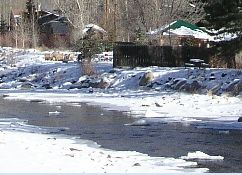 For the same reason that the tippet should be shortened, it's also important to stay low. Because the water is clearer and lower, it gives the fish a better chance at seeing you.
For the same reason that the tippet should be shortened, it's also important to stay low. Because the water is clearer and lower, it gives the fish a better chance at seeing you.
While nymphing is the best tactic for winter trout, don't put all of your dry flies away quite yet. Keep a view on your vest because in deeper pools trout may still rise. This generally occurs in tailwaters (rivers that flow from bottom-released dams). In these tailwaters, the water is moving out of the dam fast enough that the water temperature generally remains in the Trout Zone year round.
During the winter trout will also eat minnows and crayfish, but remember they won't move too far for them to conserve energy. Fishing streamers is a good tactic but just like everything else, they need to be presented next to the trout ensuring they don't need to move as much.
Remember to keep fish in the water as long as possible, especially in the winter as the outside temperature can harm and possibly kill them. Use the fundamentals of proper handling when fishing.
So don't take that fly rod out of your car just yet- or ever. Because fly fishing never hibernates. And when you're stuck in ski traffic, there's no better way than to wait it out by wading out.








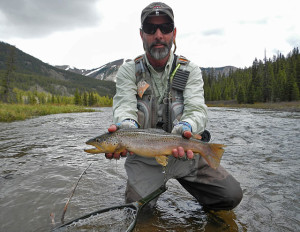 out of water will definitively kill the fish. There are tricks to minimizing air exposure and handling while still getting photo proof of your catch.
out of water will definitively kill the fish. There are tricks to minimizing air exposure and handling while still getting photo proof of your catch.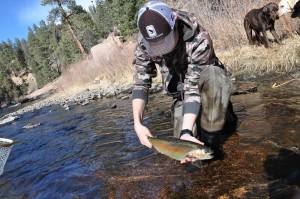 it doesn't need to leave the water). Even when the handling time is minimal, fish still need be released properly as well. When fish have experienced considerable physiological stress due to exercise and handling, they can lose their equilibrium, coordinated movements of their fins and roll or nosedive- resulting in death further on downstream.
it doesn't need to leave the water). Even when the handling time is minimal, fish still need be released properly as well. When fish have experienced considerable physiological stress due to exercise and handling, they can lose their equilibrium, coordinated movements of their fins and roll or nosedive- resulting in death further on downstream.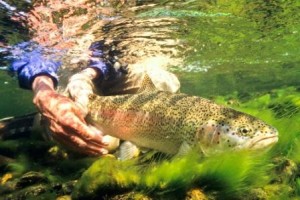 when helping it recover, do not move a fish back and forth—recall that water moving backwards over the gills does not help, but in fact, can actually harm the fish," says Dr. Danylchuck. "Let the fish go when its fins are showing coordinated movements, it can keep itself upright and it is actively trying to swim away from you."
when helping it recover, do not move a fish back and forth—recall that water moving backwards over the gills does not help, but in fact, can actually harm the fish," says Dr. Danylchuck. "Let the fish go when its fins are showing coordinated movements, it can keep itself upright and it is actively trying to swim away from you."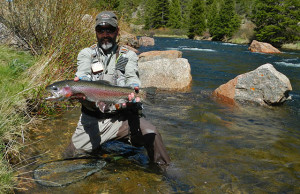 protect the resource. I was getting back into fly fishing in a big way while living in northern VA in the 90's. I became very involved at the state level in Virginia and helped with web development efforts and other projects for the VA Council of TU. In 2006, I moved to the Colorado Rockies for the mountains, rivers, and trout. I am an active member of our Gunnison Chapter of TU, the Gunnison Angling Society. I served on the Board, and was also VP and President. I built a new website for the chapter and continue to manage that, as well as chapter communications.
- What made you want to become more involved with TU?
protect the resource. I was getting back into fly fishing in a big way while living in northern VA in the 90's. I became very involved at the state level in Virginia and helped with web development efforts and other projects for the VA Council of TU. In 2006, I moved to the Colorado Rockies for the mountains, rivers, and trout. I am an active member of our Gunnison Chapter of TU, the Gunnison Angling Society. I served on the Board, and was also VP and President. I built a new website for the chapter and continue to manage that, as well as chapter communications.
- What made you want to become more involved with TU?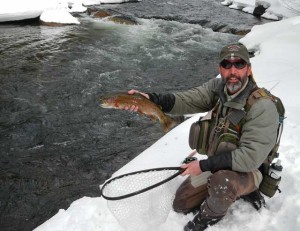
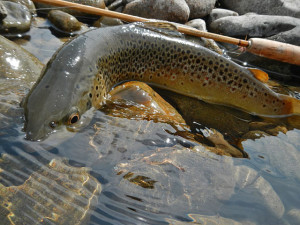 - To you, what is the best tactic or fly for catching trout?
The most important thing is patience.
That is the key word for fishing and definitely for guiding as well. You need to move slow, concentrate, and have a lot of patience and just
enjoy the ride. It’s not brain surgery. We’re just catching fish. I definitely don’t have just one top fly that I use. I enjoy dry fly fishing the most, and when I can’t do that, I love to streamer fish. So chasing big trout with a streamer is one of my favorite things to do. And for that, I like a size 4 Sculpzilla.
- To you, what is the best tactic or fly for catching trout?
The most important thing is patience.
That is the key word for fishing and definitely for guiding as well. You need to move slow, concentrate, and have a lot of patience and just
enjoy the ride. It’s not brain surgery. We’re just catching fish. I definitely don’t have just one top fly that I use. I enjoy dry fly fishing the most, and when I can’t do that, I love to streamer fish. So chasing big trout with a streamer is one of my favorite things to do. And for that, I like a size 4 Sculpzilla.



